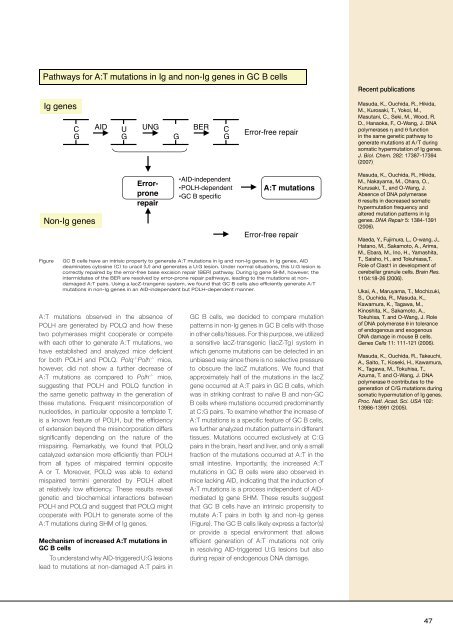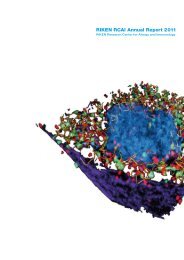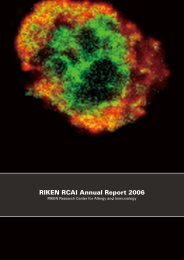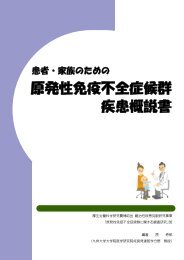in vivo
in vivo
in vivo
You also want an ePaper? Increase the reach of your titles
YUMPU automatically turns print PDFs into web optimized ePapers that Google loves.
Recent publications<br />
Masuda, K., Ouchida, R., Hikida,<br />
M., Kurosaki, T., Yokoi, M.,<br />
Masutani, C., Seki, M., Wood, R.<br />
D., Hanaoka, F., O-Wang, J. DNA<br />
polymerases η and θ function<br />
<strong>in</strong> the same genetic pathway to<br />
generate mutations at A/T dur<strong>in</strong>g<br />
somatic hypermutation of Ig genes.<br />
J. Biol. Chem. 282: 17387-17394<br />
(2007) .<br />
Masuda, K., Ouchida, R., Hikida,<br />
M., Nakayama, M., Ohara, O.,<br />
Kurusaki, T., and O-Wang, J.<br />
Absence of DNA polymerase<br />
θ results <strong>in</strong> decreased somatic<br />
hypermutation frequency and<br />
altered mutation patterns <strong>in</strong> Ig<br />
genes. DNA Repair 5: 1384-1391<br />
(2006).<br />
Figure<br />
GC B cells have an <strong>in</strong>trisic property to generate A:T mutations <strong>in</strong> Ig and non-Ig genes. In Ig genes, AID<br />
deam<strong>in</strong>ates cytos<strong>in</strong>e (C) to uracil (U) and generates a U:G lesion. Under normal situations, this U:G lesion is<br />
correctly repaired by the error-free base excision repair (BER) pathway. Dur<strong>in</strong>g Ig gene SHM, however, the<br />
<strong>in</strong>termidiates of the BER are resolved by error-prone repair pathways, lead<strong>in</strong>g to the mutations at nondamaged<br />
A:T pairs. Us<strong>in</strong>g a lacZ-trangenic system, we found that GC B cells also efficiently generate A:T<br />
mutations <strong>in</strong> non-Ig genes <strong>in</strong> an AID-<strong>in</strong>dependent but POLH-dependent manner.<br />
A:T mutations observed <strong>in</strong> the absence of<br />
POLH are generated by POLQ and how these<br />
two polymerases might cooperate or compete<br />
with each other to generate A:T mutations, we<br />
have established and analyzed mice deficient<br />
for both POLH and POLQ. Polq -/- Polh -/- mice,<br />
however, did not show a further decrease of<br />
A:T mutations as compared to Polh -/- mice,<br />
suggest<strong>in</strong>g that POLH and POLQ function <strong>in</strong><br />
the same genetic pathway <strong>in</strong> the generation of<br />
these mutations. Frequent mis<strong>in</strong>corporation of<br />
nucleotides, <strong>in</strong> particular opposite a template T,<br />
is a known feature of POLH, but the efficiency<br />
of extension beyond the mis<strong>in</strong>corporation differs<br />
significantly depend<strong>in</strong>g on the nature of the<br />
mispair<strong>in</strong>g. Remarkably, we found that POLQ<br />
catalyzed extension more efficiently than POLH<br />
from all types of mispaired term<strong>in</strong>i opposite<br />
A or T. Moreover, POLQ was able to extend<br />
mispaired term<strong>in</strong>i generated by POLH albeit<br />
at relatively low efficiency. These results reveal<br />
genetic and biochemical <strong>in</strong>teractions between<br />
POLH and POLQ and suggest that POLQ might<br />
cooperate with POLH to generate some of the<br />
A:T mutations dur<strong>in</strong>g SHM of Ig genes.<br />
Mechanism of <strong>in</strong>creased A:T mutations <strong>in</strong><br />
GC B cells<br />
To understand why AID-triggered U:G lesions<br />
lead to mutations at non-damaged A:T pairs <strong>in</strong><br />
GC B cells, we decided to compare mutation<br />
patterns <strong>in</strong> non-Ig genes <strong>in</strong> GC B cells with those<br />
<strong>in</strong> other cells/tissues. For this purpose, we utilized<br />
a sensitive lacZ-transgenic (lacZ-Tg) system <strong>in</strong><br />
which genome mutations can be detected <strong>in</strong> an<br />
unbiased way s<strong>in</strong>ce there is no selective pressure<br />
to obscure the lacZ mutations. We found that<br />
approximately half of the mutations <strong>in</strong> the lacZ<br />
gene occurred at A:T pairs <strong>in</strong> GC B cells, which<br />
was <strong>in</strong> strik<strong>in</strong>g contrast to naïve B and non-GC<br />
B cells where mutations occurred predom<strong>in</strong>antly<br />
at C:G pairs. To exam<strong>in</strong>e whether the <strong>in</strong>crease of<br />
A:T mutations is a specific feature of GC B cells,<br />
we further analyzed mutation patterns <strong>in</strong> different<br />
tissues. Mutations occurred exclusively at C:G<br />
pairs <strong>in</strong> the bra<strong>in</strong>, heart and liver, and only a small<br />
fraction of the mutations occurred at A:T <strong>in</strong> the<br />
small <strong>in</strong>test<strong>in</strong>e. Importantly, the <strong>in</strong>creased A:T<br />
mutations <strong>in</strong> GC B cells were also observed <strong>in</strong><br />
mice lack<strong>in</strong>g AID, <strong>in</strong>dicat<strong>in</strong>g that the <strong>in</strong>duction of<br />
A:T mutations is a process <strong>in</strong>dependent of AIDmediated<br />
Ig gene SHM. These results suggest<br />
that GC B cells have an <strong>in</strong>tr<strong>in</strong>sic propensity to<br />
mutate A:T pairs <strong>in</strong> both Ig and non-Ig genes<br />
(Figure). The GC B cells likely express a factor(s)<br />
or provide a special environment that allows<br />
efficient generation of A:T mutations not only<br />
<strong>in</strong> resolv<strong>in</strong>g AID-triggered U:G lesions but also<br />
dur<strong>in</strong>g repair of endogenous DNA damage.<br />
Maeda, Y., Fujimura, L., O-wang, J.,<br />
Hatano, M., Sakamoto, A., Arima,<br />
M., Ebara, M., Ino, H., Yamashita,<br />
T., Saisho, H., and Tokuhiasa,T.<br />
Role of Clast1 <strong>in</strong> development of<br />
cerebellar granule cells. Bra<strong>in</strong> Res.<br />
1104:18-26 (2006).<br />
Ukai, A., Maruyama, T., Mochizuki,<br />
S., Ouchida, R., Masuda, K.,<br />
Kawamura, K., Tagawa, M.,<br />
K<strong>in</strong>oshita, K., Sakamoto, A.,<br />
Tokuhisa, T. and O-Wang, J. Role<br />
of DNA polymerase θ <strong>in</strong> tolerance<br />
of endogenous and exogenous<br />
DNA damage <strong>in</strong> mouse B cells.<br />
Genes Cells 11: 111-121 (2006).<br />
Masuda, K., Ouchida, R., Takeuchi,<br />
A., Saito, T., Koseki, H., Kawamura,<br />
K., Tagawa, M., Tokuhisa, T.,<br />
Azuma, T. and O-Wang, J. DNA<br />
polymerase θ contributes to the<br />
generation of C/G mutations dur<strong>in</strong>g<br />
somatic hypermutation of Ig genes.<br />
Proc. Natl. Acad. Sci. USA 102:<br />
13986-13991 (2005).<br />
47





